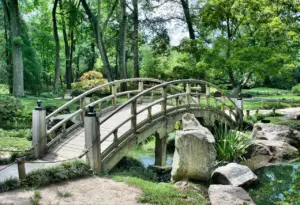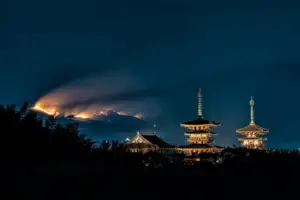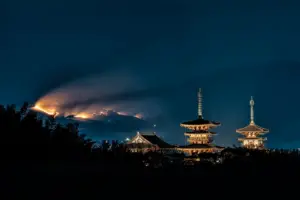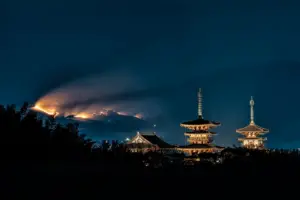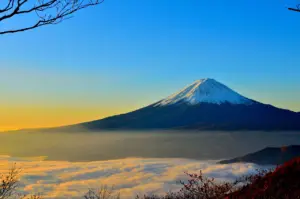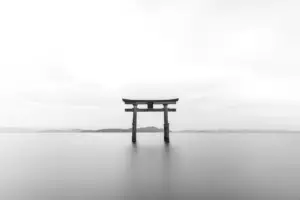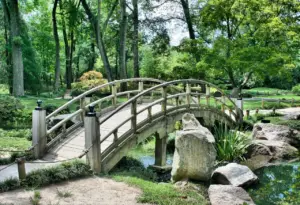If you’re a history buff, Nara is a must-visit destination in Japan. Located in the Kansai region, this ancient city is home to some of the country’s most important historical sites. From impressive temples to beautifully preserved gardens, there’s no shortage of things to see and explore.
One of the most famous landmarks in Nara is the Todai-ji Temple, a UNESCO World Heritage Site and home to the largest wooden structure in the world. If you’re looking for a glimpse of Japan’s rich cultural heritage, this is the place to be.
But that’s not all – there are plenty of other historical sites to explore in Nara, each with its own unique story to tell. So why not pack your bags, grab your camera, and get ready to discover the fascinating history of this ancient city?
Key Takeaways
- Nara is a must-visit destination for history buffs, with some of Japan’s most important historical sites.
- The Todai-ji Temple is the largest wooden structure in the world and home to Japan’s largest bronze Buddha statue.
- The Kofuku-ji Temple is one of the oldest and most important temples in Japan, featuring a five-story pagoda and impressive woodcarvings, sculptures, and paintings.
- The Isuien Garden is a tranquil oasis in the heart of Nara with historical significance, divided into front and rear gardens and open to the public.
Todai-ji Temple
You can’t leave Nara without visiting the impressive Todai-ji Temple, home to Japan’s largest bronze Buddha statue! This ancient temple was built in the 8th century and is a UNESCO World Heritage Site.
As you approach the temple, you’ll be awed by the sheer size of the wooden structure and the intricate details of its architecture. Once inside, you’ll be greeted by the sight of the Great Buddha, a majestic statue that stands 15 meters tall and weighs a whopping 500 tons.
The bronze statue is a masterpiece of Japanese art and craftsmanship, and its sheer size and beauty will leave you breathless. As you explore the temple grounds, take time to appreciate the intricate carvings and paintings that adorn the walls and pillars.
Todai-ji Temple is a testament to Japan’s rich cultural heritage and is a must-visit destination for anyone interested in history and art.
Kasuga Taisha Shrine
Visiting Kasuga Taisha Shrine is a must-see experience for anyone interested in Japanese culture and history. This shrine is one of the most important Shinto shrines in all of Japan and is considered a UNESCO World Heritage site. It was founded in 768 AD and is dedicated to the deity responsible for protecting the city of Nara and its people.
As you enter the shrine, you’ll be greeted by a sea of lanterns hanging from the ceiling. There are over 3,000 lanterns in total, and they’re all lit twice a year during the Lantern Festival.
The main hall of the shrine is also a sight to behold, with its intricate wooden carvings and beautiful architecture. Make sure to take a walk around the grounds to see the many smaller shrines and gardens that make up the Kasuga Taisha Shrine complex.
Overall, visiting this shrine is a great way to learn more about Japanese culture and history while taking in the natural beauty of the area.
Horyu-ji Temple
Located in the city of Ikaruga, the Horyu-ji Temple is a must-see destination for anyone interested in Japanese culture and architecture. As one of the oldest wooden buildings in the world, the temple has a rich history that dates back to the early 7th century.
The temple’s main hall, known as the Kondo, is particularly impressive, featuring ornate carvings and intricate details that showcase the skill and craftsmanship of the builders.
One of the most interesting aspects of the Horyu-ji Temple is its collection of Buddhist art and artifacts. In fact, the temple is home to some of the oldest surviving examples of Japanese Buddhist art, including intricate statues, paintings, and sutras.
Visitors can explore the temple’s many galleries and exhibits to get a better sense of the evolution of Buddhist art and its significance in Japanese culture.
Overall, the Horyu-ji Temple is a fascinating glimpse into Japan’s rich cultural heritage, and it’s a must-visit destination for anyone interested in history, art, or architecture.
Nara National Museum
The Nara National Museum has an impressive collection of Buddhist art and artifacts showcasing Japan’s unique cultural heritage. As you walk through the museum, you’ll see exhibits highlighting the development of Buddhism in Japan. The museum is known for its extensive collection of Buddhist statues, including those of the Buddha and Bodhisattvas. You’ll also find examples of Buddhist art from various periods, such as paintings, calligraphy, and sculptures.
One of the most interesting exhibits in the museum is the display of artifacts from the Todai-ji temple. This temple is home to the largest bronze Buddha statue in the world and is considered one of the most important religious sites in Japan. The museum’s collection includes several pieces from the temple, including a replica of the famous Nandaimon gate.
Overall, a visit to the Nara National Museum is a must for anyone interested in Japanese history and culture.
Yakushi-ji Temple
When you visit Yakushi-ji Temple, make sure to check out the East Pagoda, which is one of the oldest wooden buildings in Japan.
As you explore the Medicine Buddha Hall, take in the intricate details of the architecture and learn about the history of the temple as a healing center.
With its rich cultural significance and stunning design, Yakushi-ji Temple is a must-see destination for anyone interested in Japanese history and art.
Visit the East Pagoda
Don’t miss out on exploring the breathtaking East Pagoda in Nara, it’s a must-see! Built during the Nara period, this iconic pagoda stands at 34 meters tall and is the tallest wooden pagoda in Japan. It’s a true marvel of architectural engineering and craftsmanship, and its elegance and beauty have stood the test of time.
The East Pagoda is a five-story pagoda made entirely of wood, with each floor uniquely designed and adorned with intricate carvings and sculptures. The pagoda’s construction is a testament to the skills of ancient Japanese craftsmen, who used advanced techniques to create a structure that still stands strong today. To experience the pagoda’s grandeur up close, you can visit the nearby Nigatsu-do Hall, which offers a stunning view of the pagoda from its balcony. Don’t forget to take a stroll in the garden surrounding the pagoda, where you can admire the beautiful cherry blossoms in spring and the vibrant foliage in autumn.
Explore the Medicine Buddha Hall
You’ll be amazed by the intricate details and peaceful atmosphere of the Medicine Buddha Hall in Nara. This historical site is a must-visit for anyone interested in Buddhism and Japanese culture.
The hall houses a statue of the Medicine Buddha, which is said to have the power to heal physical and mental illnesses. The Medicine Buddha Hall is adorned with beautiful paintings and carvings that depict the life of the Buddha and his teachings.
The ceiling of the hall is particularly impressive, with its intricate wooden lattice work and gold leaf embellishments. As you walk through the hall, you’ll feel a sense of tranquility and calmness that is hard to find in today’s fast-paced world.
So, take your time and soak in the peaceful atmosphere of this historical site.
Learn About the Temple’s History
Immerse yourself in the rich history of the temple and feel a sense of awe as you discover the stories behind its ancient walls. As one of the oldest temples in Japan, the Medicine Buddha Hall has a long and fascinating history that stretches back over a thousand years. From its founding by the monk Gyoki in the early 8th century to its reconstruction in the early 17th century, the temple has witnessed many important events and played a central role in the religious and cultural life of Nara.
To help you understand the temple’s history and significance, be sure to visit the informative displays and exhibits located throughout the complex. These displays cover a wide range of topics, from the temple’s founding and early history to its role in the development of Japanese Buddhism and its connections to other important historical sites in Nara. To get started, check out the table below, which provides a brief overview of some of the most important events and figures associated with the temple. With this information in mind, you’ll be able to appreciate the temple’s many layers of meaning and significance and gain a deeper appreciation for its ancient beauty and spiritual power.
| Event/Figure | Date | Significance |
|---|---|---|
| Gyoki | 668-749 | Founder of the temple |
| Emperor Shomu | 701-756 | Patron of the temple |
| Nanto Shichi Daiji | 13th-14th century | Important pilgrimage route |
| Oda Nobunaga | 1534-1582 | Burned down original temple |
| Tokugawa Ieyasu | 1543-1616 | Rebuilt temple in early 17th century |
Isuien Garden
The Isuien Garden is a tranquil oasis in the heart of Nara, where visitors can stroll among lush greenery and serene ponds. The garden dates back to the Edo Period and is divided into two sections: the front garden and the rear garden.
The front garden features a pond with a small island, a tea house, and a waterfall. The rear garden, on the other hand, is more spacious and features a large pond, a teahouse, and a stone garden.
The Isuien Garden is not only a beautiful place to visit but it also holds historical significance. The garden was once part of the Todaiji Temple and served as a place for priests to relax and meditate. The garden was later donated to the city of Nara in the Meiji Period and has since been open to the public.
Visiting the Isuien Garden is a great way to escape the hustle and bustle of the city and immerse yourself in the tranquility of Japanese nature and history.
Kofuku-ji Temple
Kofuku-ji Temple, located in the heart of Nara, is a must-visit for those interested in Japanese Buddhism. The temple is one of the oldest and most important in the country, with a history that dates back over 1,300 years.
It was originally founded in Kyoto in the 7th century, but was moved to Nara in the 8th century, where it became the head temple of the influential Hosso sect.
One of the most impressive features of Kofuku-ji Temple is its five-story pagoda, which stands at a towering 50 meters tall. Built in the early 15th century, it is the second tallest pagoda in Japan and an iconic symbol of Nara.
The temple complex also includes a number of other impressive buildings and structures, including the Central Golden Hall, the Eastern Golden Hall, and the Nan’endo Hall. Visitors can explore the halls and admire the intricate woodcarvings, sculptures, and paintings that adorn the walls and ceilings.
Yoshiki-en Garden
Located just a short walk from Kofuku-ji Temple, you can experience the serene and peaceful atmosphere of Yoshiki-en Garden. This garden is a traditional Japanese garden that has been carefully designed and maintained for centuries, making it a perfect spot for those who want to escape from the hustle and bustle of the city.
As you stroll through the garden, you’ll see a variety of stunning plants and trees, including cherry blossoms, pine trees, and maple trees. The garden also features a large pond filled with koi fish, which adds to the peaceful and tranquil ambiance.
Additionally, the garden is designed to incorporate the surrounding landscape, including the nearby mountains, making it a truly immersive experience.
Whether you’re a nature lover or just looking for a peaceful place to relax, Yoshiki-en Garden is a must-visit spot for anyone exploring Nara’s historical sites.
Frequently Asked Questions
What is the history behind the construction of Todai-ji Temple?
The history behind the construction of Todai-ji Temple is a fascinating one. You see, the temple was built during the Nara period (710-794 AD) in order to solidify the capital’s power and to promote Buddhism.
It was Emperor Shomu who commissioned the temple’s construction, and it took a staggering 10 years to complete. The temple itself is awe-inspiring, as it is the largest wooden structure in the world, and is home to the Great Buddha, a bronze statue standing at over 15 meters tall.
The construction of Todai-ji Temple was a massive undertaking, and it remains one of the most important sites in Nara, attracting visitors from all over the world.
How long does it take to explore Kasuga Taisha Shrine?
If you’re planning to explore Kasuga Taisha Shrine in Nara, you should keep in mind that the amount of time you spend there will depend on your interests and curiosity level. However, it’s good to know that the shrine is quite large and has many different areas to explore, including the main hall, the treasure hall, and the many lanterns scattered throughout the complex.
Typically, visitors spend around 1-2 hours at Kasuga Taisha Shrine, but if you want to fully appreciate all the details and history of the shrine, you might want to spend more time there. It’s worth noting that the shrine can get quite crowded, especially during peak season, so you may want to plan your visit accordingly.
Overall, Kasuga Taisha Shrine is a must-visit destination for anyone interested in Japanese history and culture, and it’s definitely worth taking the time to explore.
What artifacts are on display at Horyu-ji Temple?
If you’re curious about the artifacts on display at Horyu-ji Temple, you’re in for a treat. This UNESCO World Heritage site is home to an incredible collection of Buddhist art and architecture, including some of the oldest wooden buildings in the world.
As you explore the temple grounds, you’ll have the chance to see a wide variety of treasures, from ancient statues and paintings to intricate carvings and calligraphy. Highlights include the famous Kudara Kannon statue, which dates back to the 7th century, as well as the iconic five-story pagoda and the Golden Hall, which houses an impressive collection of Buddhist relics.
Whether you’re a history buff or simply looking for a unique cultural experience, Horyu-ji Temple is not to be missed.
Can visitors take photographs inside Nara National Museum?
Yes, visitors are allowed to take photographs inside Nara National Museum, but there are certain restrictions to be followed.
Flash photography is strictly prohibited, and visitors are required to turn off the sound of their camera devices.
Additionally, some of the exhibits may have restrictions on photography due to their fragile nature, so it’s advisable to check with the museum staff before taking any photographs.
The Nara National Museum is an excellent place to learn about the rich cultural heritage of Japan, and photographing the exhibits is a great way to preserve memories of your visit.
So, go ahead and snap away, but do so with care and respect for the exhibits and other visitors.
Are there any special events or festivals held at Yakushi-ji Temple throughout the year?
Yes, there are several special events and festivals held at Yakushi-ji Temple throughout the year. One of the most popular events is the Yakushi-ji Temple Autumn Festival, which takes place in late November and early December. During this festival, visitors can see the temple’s beautiful autumn foliage and enjoy traditional Japanese music and dance performances.
In addition, the temple holds regular Buddhist ceremonies and rituals throughout the year, which are open to the public. If you plan to visit Yakushi-ji Temple, be sure to check its website or ask at the entrance for information about upcoming events and ceremonies.
Conclusion
So, there you have it! Nara is a city full of rich history and cultural heritage, and there’s something for everyone to explore and learn about. These five historical sites are just the tip of the iceberg.
From the awe-inspiring Todai-ji Temple and the tranquil Yakushi-ji Temple to the colorful Kasuga Taisha Shrine and the informative Nara National Museum, Nara offers a variety of experiences.
As you wander through the ancient streets of Nara, take in the stunning sights and sounds that surround you. Immerse yourself in the local culture, try some delicious Japanese cuisine, and marvel at the incredible feats of architecture and craftsmanship that have stood the test of time.
Whether you’re a history buff or simply looking for a unique travel experience, Nara is a city that should not be missed. So pack your bags, grab your camera, and get ready to explore all that this amazing destination has to offer!












